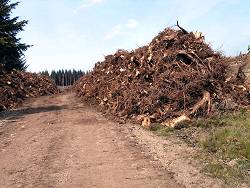Summary
Background
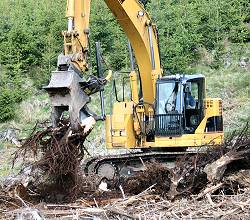
The requirement to reduce carbon emissions has led to the development of alternative energy sources, including biomass for fossil fuel substitution. Forest harvesting residues are increasingly being used to supply biomass for heat and power generation in the UK and attention is now turning to the utilisation of tree stumps. Some private sector forestry companies in South Scotland have begun to extract stumps from harvested conifer plantation sites to provide biomass for local power plants.
Maintaining sustainable forest management
Stump harvesting poses a number of risks to the forest environment that can threaten sustainable forest management. However, where these risks can be reduced to a low level, the benefits of increasing the use of biomass may outweigh the potential disadvantages. Forest Research has worked with the Forestry Commission and the forest industry to develop interim guidance to minimise the risks through careful site selection and good practice.
The four principal risks to soil sustainability from stump harvesting are:
- Increased soil damage due to compaction, rutting and disturbance leading to erosion and increased turbidity and siltation of local watercourses.
- Removal of essential major and micronutrients (e.g. nitrogen, phosphorus, potassium and boron), leading to lower soil fertility, and potential loss of tree growth in subsequent rotations.
- Removal of base cations (calcium, magnesium, sodium and potassium) reducing soil buffering capacity and leading to increased soil and stream water acidification.
- Increased carbon loss from disturbed soil after stump harvesting leading to reduced soil carbon stock.
The guidance addresses these risks based on a knowledge of main soil types, slope and other relevant constraints. Recommendations on good practice will help to protect sites from damage.
The guidance is largely based on expert judgement of the scientific issues informed by practical experience of managing forest soils. Uncertainties remain about the long-term sustainability of stump harvesting on certain soil types, which will require new research to quantify impacts and check that the guidance is fit for purpose.
Stump harvesting guidance
FC_stump_harvesting_guidance_April09.pdf (PDF-905K)
Guidance to assist the forest industry in identifying sites where stumps may be harvested without compromising long-term sustainability, and on any environmental safeguards that must be applied.
Further information
- Site planning to facilitate stump harvesting
- Stump harvesting systems
- Ongoing research work and publications relevant to stump harvesting
Contacts
Further information on Forest Research work that is relevant to issues related to stump harvesting and brash removal is available from Tom Nisbet (tom.nisbet@forestry.gsi.gov.uk) and Bruce Nicoll (bruce.nicoll@forestry.gsi.gov.uk).
Ongoing research work and publications relevant to stump harvesting
Research
Interim guidance is largely based on expert judgement of the scientific issues informed by practical experience of managing forest soils. Uncertainties remain about the long-term sustainability of stump harvesting on certain soil types, which will require new research to quantify impacts and check that the guidance is fit for purpose.
Publications
- Stump harvesting: interim guidance on site selection and good practice (PDF-905K)
Guidance to assist the forest industry in identifying sites where stumps may be harvested without compromising long-term sustainability, and on any environmental safeguards that must be applied. April 2009. - Whole-Tree Harvesting: A Guide to Good Practice (PDF-370K)
Forestry Practice Guide. Forestry Commission, Edinburgh. 1997. - Forests and Soil Guidelines
Forestry Commission, Edinburgh. 2011. - Forests and Water Guidelines
Forestry Commission, Edinburgh. 2011. - The UK Forestry Standard
Forestry Commission, Edinburgh. 2011. - Protecting the environment during mechanised harvesting operations (PDF-1070K)
Forestry Commission Technical Note 11. Forestry Commission, Edinburgh. 2005. - Managing brash on conifer clearfell sites (PDF-2340K)
Forestry Commission Practice Note. Forestry Commission, Edinburgh. 2006. - Guidance for site selection for brash removal (PDF-1078K)
Final protocol. Forest Research, Farnham, UK. 2007.
Site planning to facilitate stump harvesting
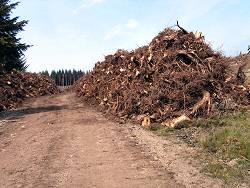
As with all forest operations, good site planning is fundamental to stump harvesting.
It will be essential to consider the potential environmental impacts on a site and to liaise with appropriate bodies to assess the sensitivity of the area and the existence of any legal requirements.
There will be a need for a detailed site assessment before any operations commence, including identifying all hazards associated with the lifting, transport and storage of stumps.
In addition to soil and water protection, stump harvesting is potentially damaging to biodiversity and the historic environment. Consideration must therefore be given to the needs of priority and protected plant and animal species, and to local archaeology, when assessing site suitability.
Another consideration for site selection is the availability of space for stacking and handling of stumps at roadside (see photo), including the capacity and condition of the forest road and track infrastructure to cope with the increased number of vehicle movements. Particular care will be required to ensure that stump stacks do not block or pollute roadside drains.
Stump harvesting systems
The most widely used stump harvesting system in the UK is a tracked excavator with a purpose built head for destumping. The head is used to pull stumps out of the ground, and then split and shake them in an attempt to remove soil:
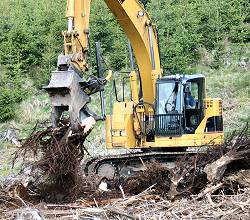
The processed stumps are temporarily placed in adjacent ‘wind-rows’:
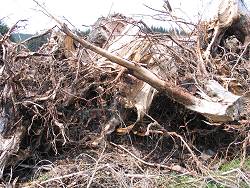
The stumps are then extracted by forwarder to road side for storage before being taken by truck to be chipped and burned:
